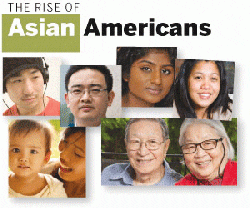WASHINGTON — Asia has surpassed Latin America as the largest source of new immigrants to the United States, according to a major new report that found that Asian-Americans also enjoy the highest incomes and best education of any racial group in the United States.
The 214-page report, released Tuesday by the Pew Research Center, said Asian-Americans now constitute nearly six percent of the total U.S. population, or some 18.2 million people. That’s a more than five-fold increase since 1965, when immigration laws were liberalized to permit more non-Europeans to come to the United States.

|
| The 214-page report, released Tuesday by the Pew Research Center, said Asian-Americans now constitute nearly six percent of the total U.S. population, or some 18.2 million people. |
Asian immigration has risen steadily since 1965, according to the report, entitled “The Rise of Asian Americans,” but the growth rate appears to have accelerated in the last few decades, with nearly three out of every four Americans with Asian ancestry having been born abroad. Japanese-Americans are the only sub-group in which the majority was born in the United States.
“A century ago, most Asian Americans were low-skilled, low-wage laborers crowded into ethnic enclaves and targets of official discrimination,” the report stated. “Today they are the most likely of any major racial or ethnic group in America to live in mixed neighborhoods and to marry across racial lines.”
This shift is part of a trend that would seem to indicate that Americans are becoming more tolerant towards immigrants, especially Asian-American ones. A 2010 Pew survey found that among white Americans, 62 percent “would be fine” with a relative marrying interracially, particularly someone who is black, Hispanic or Asian, up from 51 percent in 2001.
Chinese-Americans comprised the largest sub-group of all Asian-Americans, with about four million people, or about 23 percent of the total. They were followed by Filipino-Americans (3.4 million), Indian-Americans (3.2), Vietnamese-Americans (1.74), Korean-Americans (1.71) and Japanese-Americans (1.3). Together, those six sub-groups are the vast majority of the total Asian population in the United States.
Traditional values: Education and hard work
“Many Asians come to the United States because they still perceive it as a land of opportunity,” Andrew Lam, an editor at New America Media, an umbrella group of ethnic news organizations, told IPS.
The report, based in part on recent telephone interviews in English and seven other languages with a nationally representative sample of more than 3,500 Asian-Americans, also found that Asian-Americans place significantly more emphasis on attaining higher education and working hard than other racial groups in the United States.
While 93 percent of respondents in the poll said they believed that Americans who hailed from the same country of origin are “very hard-working,” only 57 percent of those respondents agreed that the same held true for their American counterparts as a whole.
Asian-Americans stand out for their educational achievements, in particular. While 26 percent of the U.S. population has a bachelor’s degree or higher, the comparable figure for Asians is 49 percent – nearly twice as high – and 18 percentage points higher than white Americans. The more recent arrivals have an even higher percentage – 61 percent among adults aged 25 to 64.
Asian-Americans also stand out compared to their cohorts in their home countries. On average, about 26 percent of Japanese and South Koreans in the same age group have a bachelor’s degree, compared to nearly 70 percent of comparably aged recent immigrants from those two countries.
Financial and economic aspects
According to the Department of Labor, the unemployment rate among Asians as a group is less than in America as a whole. The Asian-American unemployment rate stands at about 7.5 percent, lower than any other demographic, including white (8.7 percent), black (16) and Hispanic (12.5) and lower than the national unemployment rate of 8.2 percent.
The view among various Asian groups can differ significantly in terms of education and income. Indian-Americans, for example, lead all other sub-groups in both categories. Americans with Korean, Vietnamese or Chinese ancestry suffer higher poverty rates than does the general public, while those with Indian, Japanese or Filipino origins have lower rates.
And while the median household income in 2010 for the general U.S. population was nearly 50,000 dollars, for Asian-Americans the median figure was 66,000, according to the report.
Findings from the U.S. Census Bureau fall along the similar lines: between 2002 and 2007, Asian-owned businesses increased 40.4 percent – nearly twice the national rate – amounting to 1.5 million total businesses, generating more than half a trillion dollars in receipts and employing nearly three million people.
“Asian-owned businesses continued to be one of the strongest segments of our nation’s economy,” said Census Bureau Deputy Director Thomas Mesenbourg.
Asians’ success, however, has not helped alleviate racial tensions. In April, D.C. Councilman Marion Barry was caught on tape making derogatory comments about Asian-Americans and their businesses.
“We’ve got to do something about these Asians coming in, opening up businesses – those dirty shops,” Barry said, after winning his city’s Democratic primary, “They ought to go.”
Census data compiled by Pew suggests that Asian immigrants outnumbered Hispanic immigrants at some point between 2007 and 2010. In 2007, about 540,000 Hispanics – both documented and undocumented – came to the United States, while only 390,000 Asians did so.
But by 2010, about 430,000 Asians – or 36 percent of all new immigrants – arrived here, compared to about 370,000 Hispanics.
The reversal appears to have resulted primarily from a decrease in Hispanic immigration, particularly after the 2008 financial crisis, when a combination of harsh anti-immigrant legislation at the state level, tighter border security, and the slump in the U.S. economy (especially its construction industry, where many male Hispanic immigrants have found work) discouraged many would-be immigrants from crossing the border.
-IPS






Leave a Reply